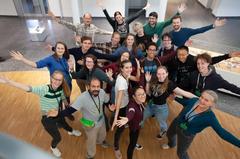These high-school students will conduct their experiments at a beamline at DESY for the next two weeks. Image: DESY, Joseph Piergrossi
DESY Chain and Particle Peers have landed on the DESY campus! These two groups of high school students, respectively from Salt Lake City in the USA and Groningen in the Netherlands, are winners of the Beamline for Schools international competition and will spend the next two weeks in Hamburg at the DESY-II particle accelerator, performing the experiments they proposed.
Beamline for Schools (BL4S), which started in 2014, is a competition wherein teams of high school students from around the world propose experiments that require a particle beam to be performed. For this year’s competition, 178 teams from 49 countries submitted proposals, which consisted of a written proposal as well as a video. Usually, the winners of BL4S perform their work at CERN in Geneva, Switzerland. However, since the Large Hadron Collider at CERN is undergoing upgrades and all accelerators are therefore shut down, CERN has teamed up with the German physics lab DESY, and the students will run their experiments there.
Two winning teams were selected from a twenty-team shortlist. One of the winning teams is DESY Chain, consisting of eight students from West High School in Salt Lake City, Utah in the USA. DESY Chain wants to test the sensitivity of special materials called scintillators, which fluoresce when they interact with particles such as electrons or positrons. Scintillators are key components of nearly every particle detector in use.
“I love the idea of applying some of the theories I’ve learned about,” says DESY Chain member Arianna Meinking. “I can’t wait to explore the limits of my physics dreams in a real lab!”
Particle Peers, the winning team from Groningen in the Netherlands, comprises six students who will compare particle showers from electron and positron beams. When accelerated electrons or positrons collide with a target, the energetic scatters that result can transform into various different particles. The Particle Peers will see if they can detect any difference between the scatters originating from matter and those from antimatter.
“I’m thrilled to meet the students from the other side of the world and to work together on something we are both excited about,” says Particle Peers member Ilja de Goede.
Both groups will live on the DESY campus for two weeks and run their experiments at beamlines at the DESY-II synchrotron, the original and namesake accelerator ring of the DESY research facility. Apart from providing beams to experiments, DESY-II now acts as the booster ring for the storage ring synchrotron light source PETRA III.
“Both of these projects, by promising young minds, will not only potentially stimulate new findings, but will also help encourage these and many other young people to have a deeper look into not just particle or accelerator physics but science in general,” says Helmut Dosch, Chairman of the DESY Board of Directors.
BL4S is organised by the CERN & Society Foundation as an Education and Outreach project. For 2019, additional funding was contributed by the Wilhelm and Else Heraeus Foundation, with further donations from the Motorola Solutions Foundation, Amgen Switzerland AG, and the Ernest Solvay Fund, which is managed by the King Baudouin Foundation.








